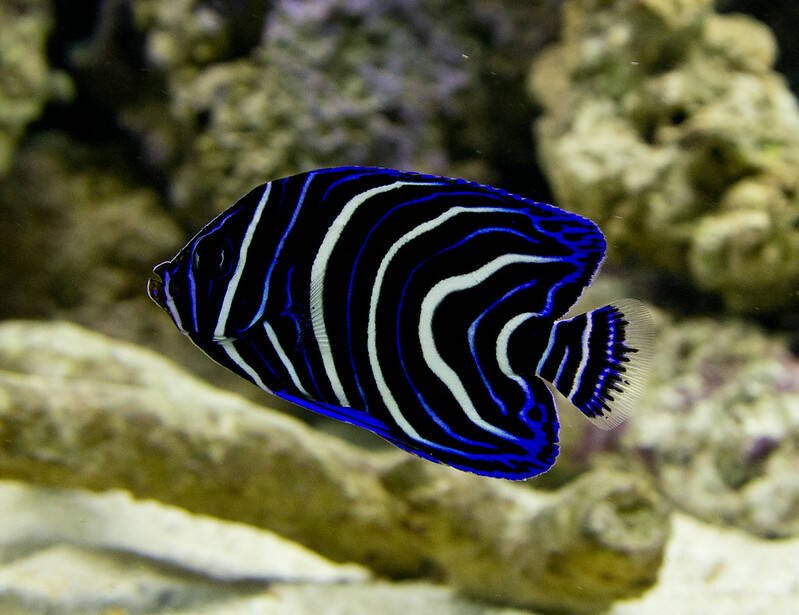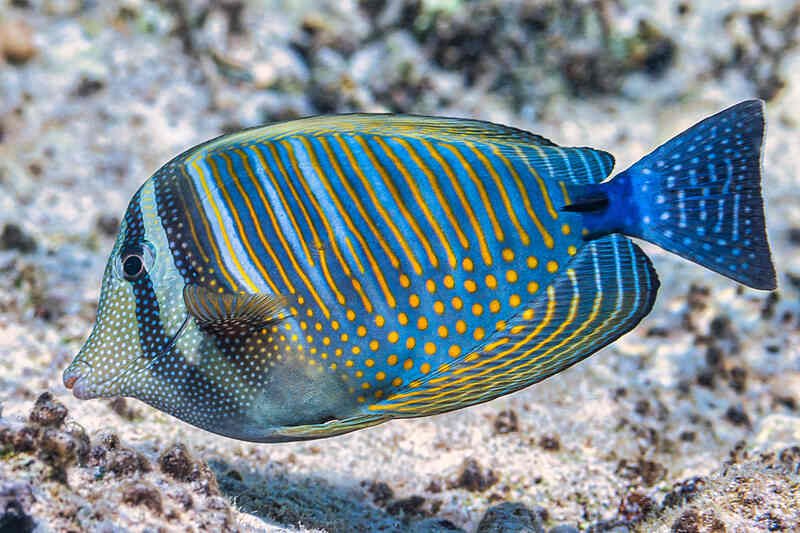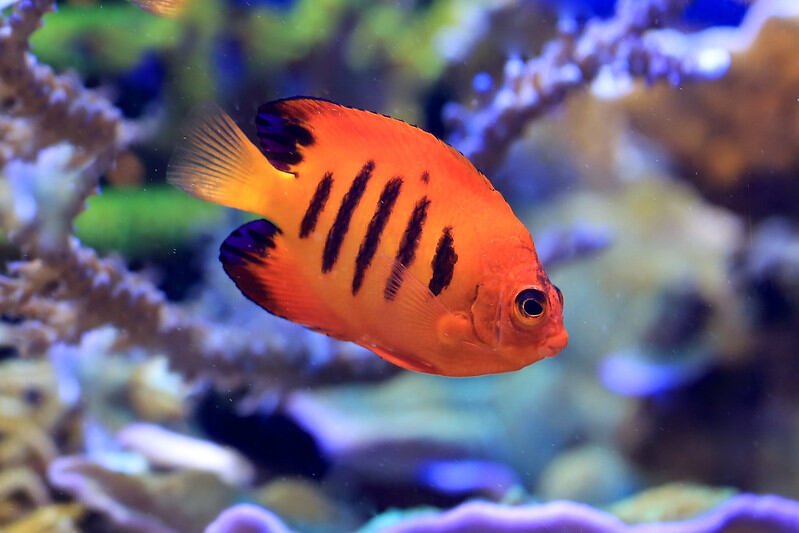The Koran Angelfish (Pomacanthus semicirculatus), also known as the Semicircle Angelfish, is a mesmerizing addition to any saltwater aquarium. It’s famed for its striking colors and elegant circular patterns, which evolve as the fish matures. However, keeping this species comes with specific challenges that require dedicated care. In this article, I’ll share my experience and offer practical tips for successfully maintaining Koran Angelfish in your saltwater aquarium.
Why Choose Koran Angelfish?
One of the most beautiful members of the Angelfish family, the Angelfish is a popular choice among aquarists for its vibrant blue, green, and yellow hues. As juveniles, these fish display brilliant blue and white semicircles across their bodies, which transform into a more intricate pattern as they mature.
But it’s not just the aesthetics that make Angelfish attractive. They are robust, hardy fish that can thrive in home aquariums if provided with the right environment. Their active swimming behavior and inquisitive nature make them engaging to watch, but keep in mind that they are also territorial and can be aggressive, especially as adults.
Aquarium Size and Setup
Tank Size
The tank size is one of the most crucial aspects of keeping a Koran Angel. These fish grow quite large, reaching up to 15 inches (38 cm) in length. This means they require ample space to swim and explore. In my experience, a minimum of 150 gallons is recommended for a single adult Koran Angel. However, larger tanks are always better for maintaining a stable environment and ensuring the fish has plenty of room.
Water Conditions
Maintaining the correct water parameters is essential for the health of your Koran Angel. Here are the key factors to monitor:
- Temperature: Maintain the water’s temperature between 22°C and 28°C, or 72°F and 82°F.
- pH Level: A pH range of 8.1 to 8.4 is ideal for saltwater fish, including Koran Angel. Regular testing is necessary to maintain this balance.
- Specific Gravity/Salinity: The salinity of the tank should be between 1.020 and 1.025. I recommend using a refractometer for precise measurement.
In my experience, regular water changes (20% every 2-4 weeks) help maintain pristine water quality. The Koran Angel is sensitive to poor water conditions, and dirty water can lead to health problems such as ich or fin rot.
Filtration and Flow
Since produces a considerable amount of waste, a robust filtration system is necessary. The water will remain clean with the help of mechanical, biological, and chemical filtration. I prefer using protein skimmers to remove organic waste before it breaks down in the water.
Water movement is also essential. Although the Koran Angel doesn’t need strong currents, a moderate water flow will mimic their natural reef environment, ensuring better oxygenation and preventing dead spots in the tank.
Tank Mates
can be aggressive, particularly as they grow older. In my experience, they tend to become territorial, especially in smaller tanks. As such, choosing suitable tank mates is important to avoid conflicts.
Ideal tank mates for a Koran Angel are similarly sized or larger species that can hold their own in a semi-aggressive environment. Some good choices include:
- Tangs (Surgeonfish): These fish are fast swimmers and can coexist well with Koran Angel.
- Wrasses: These active, vibrant fish usually keep to themselves and make good companions.
- Triggerfish: They can be a good match due to their size and temperament, though caution is needed as both species can be aggressive.
Avoid housing them with smaller, docile fish like gobies or blennies, as they may be bullied. Additionally, refrain from keeping more than one large angelfish koran species unless you have an enormous tank, as territorial disputes will likely occur.
Feeding the Koran Angelfish
The diet of Angelfish should be varied and rich in nutrients to keep them healthy and vibrant. In the wild, these fish are omnivores, feeding on sponges, algae, and small invertebrates. In captivity, replicating this diet is essential.
Food Types:
- Sponges and Algae: While sponges are their natural diet, they aren’t easy to provide in an aquarium setting. However, I’ve found that high-quality, sponge-based angelfish preparations (frozen or pellet forms) work well.
- Algae Sheets: Seaweed or algae sheets provide essential fiber and can be clipped to the tank for grazing.
- Meaty Foods: Offer protein-rich foods like mysis shrimp, brine shrimp, and krill. These should be given 2-3 times a week.
- Frozen and Flake Foods: Angelfish also appreciate a mix of frozen preparations or high-quality flake foods.
Feeding should be done 2-3 times per day, and portions should be small enough that the fish can consume all the food in a couple of minutes. Overfeeding is a common mistake and can lead to water quality issues.
Breeding Challenges
Breeding in captivity is exceedingly difficult, and it’s rarely attempted by hobbyists. These fish require large open spaces, specific water conditions, and precise lighting cycles to simulate natural breeding conditions. Furthermore, the larvae are incredibly delicate and difficult to raise.
If you’re interested in breeding angelfish, I recommend researching smaller species, as Angelfish koran presents too many challenges for the average aquarist.
Behavior and Interaction
One of the joys of keeping Angelfish is their personality. These fish are curious and will often explore every corner of the tank. Over time, they become accustomed to their owners and will frequently swim to the front of the tank during feeding times or when they see someone approach.
However, Angelfish can also be territorial. I’ve found that introducing them as the last fish into an established community can help minimize aggression. Additionally, providing plenty of hiding spaces, such as live rock formations and caves, allows for a more peaceful tank dynamic.
Juvenile vs. Adult Behavior
Juvenile Angelfish tend to be more peaceful and easier to manage in community settings. As they mature, their behavior can shift, becoming more assertive, particularly towards other fish that enter their territory. Keeping the tank spacious and maintaining a clear hierarchy among tank mates can mitigate issues as they grow.
Common Health Issues
Angelfish koran are generally hardy, but like any saltwater species, they are susceptible to certain diseases if the tank environment isn’t properly maintained. Here are some common health issues and how to address them:
- Marine Ich (Cryptocaryon irritans): This is one of the most common diseases in saltwater fish. Ich appears as white spots on the body and fins. If caught early, raising the tank temperature slightly and using copper-based medications can help eradicate the parasite.
- Fin Rot: Poor water quality is often the cause of fin rot, where the fish’s fins become ragged and begin to disintegrate. Keeping the water clean and using antibacterial treatments can resolve the issue.
- Head and Lateral Line Erosion (HLLE): This condition is often linked to poor diet, particularly a lack of vitamins or minerals. Feeding a varied diet rich in vitamins C and A can help prevent this condition.
Koran Angel is a rewarding yet challenging species to keep. Their stunning beauty and engaging personalities make them a showpiece in any saltwater aquarium, but they do require careful attention to water quality, diet, and tank size. If you’re prepared for the commitment, keeping a Koran Angel can be an incredibly satisfying experience.
In my journey of maintaining these majestic creatures, the key lessons I’ve learned are patience and consistency. With the right care and environment, will thrive, and you’ll continue to be captivated by their ever-changing beauty. Whether you’re a seasoned aquarist or a dedicated beginner, these fish can bring a sense of the ocean’s wonder right into your home.
Keep Koran Angelfish / Saltwater Aquarium Fish
Koran Angel (Pomacanthus semicirculatus), also known as semicircle angelfish, is one of the most captivating saltwater fish you can add to a marine aquarium. With their stunning transformation from bright blue and white juveniles to striking green and yellow adults, they are a favorite among aquarists. However, keeping angelfish can be a challenge, as these fish require specific care and a well-maintained environment to thrive. This guide will walk you through the key aspects of keeping Koran angel in a saltwater aquarium, covering everything from tank setup and diet to water quality and common challenges.
Understanding Koran Angelfish / What You’re Getting Into
Angelfish are known for their beauty, but they also come with particular needs that make them more suited for experienced aquarists. Before beginning, you should be aware of the following:
Size and Growth: Angelfish can grow up to 15 inches (38 cm) in captivity. As juveniles, they are small and can live in moderate tanks, but as they mature, they will require a larger space to move comfortably.
Lifespan: With proper care, Angelfish ckoran an live up to 15 years or more in an aquarium setting.
Temperament: These angelfish can be territorial, especially as adults, and may not get along well with smaller or more docile fish. They are best kept with other semi-aggressive tank mates or in a species-only setup.
Keeping a Koran angel requires a deep commitment to providing an environment that can accommodate their size, behavior, and dietary needs.
Note: Read Mor: Aquarium books and How to Remove Broum Algae Aquarium.
Setting Up the Ideal Tank for Koran Angelfish
A well-constructed tank is the foundation for a healthy Koran angel. Here are the key considerations:
a) Tank Size
Given the Koran angelfish’s potential size, you’ll need a large tank. For one adult, a minimum of 125 gallons (473 liters) is advised. This ensures that they have enough space to swim and explore without feeling cramped. Juveniles can start in a smaller tank but be prepared to upgrade as they grow.
b) Aquascaping and Décor
Koran angels are naturally found around coral reefs and rocky areas in the wild, so recreating a similar environment will make them feel more comfortable. Provide plenty of hiding spots using live rock or artificial caves. These fish enjoy exploring and will seek out crevices to retreat to when stressed or resting.
Be mindful of their tendency to nip at corals, especially soft corals. If you’re setting up a reef tank, select coral species that are more resilient or avoid corals entirely.
c) Water Parameters
Maintaining stable water conditions is crucial for the health of Koran Angel. Aim for the following water parameters:
- Temperature: 72°F – 82°F (22°C – 28°C)
- pH Level: 8.1 – 8.4
- Salinity: 1.020 – 1.025 specific gravity
- Ammonia/Nitrite: 0 ppm (parts per million)
- Nitrate: Less than 20 ppm
Regular water changes (about 20% bi-weekly) and high-quality filtration are essential to keep these parameters stable.
d) Lighting
Koran angels don’t have specific lighting needs, but it’s important to provide a day/night cycle to mimic their natural environment. Moderate to strong lighting is sufficient, depending on whether you’re keeping corals or just live rock in the tank.
Diet and Nutrition: Feeding Your Koran Angelfish
In the wild, Korans are omnivores, feeding on algae, sponges, small invertebrates, and plankton. Replicating this diet in captivity is important for their health and vibrancy.
a) Staple Foods
- Algae-Based Foods: Provide a variety of marine algae, either in the form of dried seaweed sheets (nori) or algae flakes/pellets. These angelfish need a constant supply of plant matter in their diet to remain healthy.
- Meaty Foods: Offer a mix of protein-rich foods such as brine shrimp, mysis shrimp, and finely chopped seafood like squid and shrimp. Frozen or fresh foods are best to ensure they get enough protein.
- Angelfish-Specific Foods: There are many prepared foods designed specifically for large angelfish species. These often contain a mix of plant and animal matter to meet their nutritional needs.
b) Feeding Frequency
Feed the Koran two to three times per day in small amounts. They are grazers in the wild, so providing food more frequently will mimic their natural feeding behavior and prevent overfeeding, which can lead to poor water quality.
c) Supplements
To support their immune system and vibrant coloration, consider adding vitamin-enriched foods or supplements to their diet. Spirulina-based foods are a great option for maintaining their color and health.
Compatible Tank Mates for Koran Angelfish
Choosing the right tank mates is crucial when keeping Koran angels, especially since they can become aggressive or territorial as they grow.
a) Compatible Species
- Other Large Angelfish: If you have a large enough tank, angelfish can sometimes coexist with other large angelfish koran species, such as emperor angelfish or queen angelfish. However, introduce them carefully to avoid territorial disputes.
- Semi-Aggressive Fish: Fish like tangs, large wrasses, and triggerfish can coexist with them, as long as there is enough space to reduce territorial behaviors.
- Bottom-Dwelling Fish: Species like gobies and blennies can live peacefully with angelfish, as they tend to stay out of each other’s way.
b) Fish to Avoid
Avoid keeping with small, delicate species like clownfish, dartfish, or smaller wrasses. These fish are likely to be harassed by the angelfish, especially as it matures and becomes more territorial.
Additionally, be cautious when mixing with coral-dwelling fish if you’re running a reef setup, as their natural tendency to nip at corals may cause conflict.
Common Problems and How to Address Them
a) Territorial Aggression
As mentioned earlier, angelfish can be aggressive towards other tank inhabitants, especially if they feel their territory is being invaded. To mitigate this, ensure that your tank is large enough and has plenty of hiding places. Introducing all fish simultaneously and rearranging the rockwork before adding new fish can also help reduce aggression.
b) Coral Nipping
Koran angels have a notorious reputation for nipping at corals, particularly soft corals and zoanthids. If you’re planning to keep corals, monitor your fish closely. You may need to remove sensitive species or provide additional food to distract them from grazing on your corals.
c) Health Issues
Koran angels are susceptible to common saltwater diseases, such as marine ich (Cryptocaryon irritans) and velvet disease (Amyloodinium). To prevent outbreaks, quarantine new fish before introducing them to your main tank and maintain excellent water quality. Supplement their diet with garlic-based foods and immune-boosting additives to help ward off parasites.
Tips for Long-Term Success
a) Patience and Observation
Koran angels are long-lived and require consistent care. Regular observation of their behavior, diet, and overall appearance is key to catching any issues early.
b) Proper Tank Maintenance
Keeping up with water changes, testing water parameters, and cleaning your tank equipment is essential for maintaining a healthy environment. Invest in high-quality filtration systems, protein skimmers, and UV sterilizers to keep the water pristine.
c) Research
Before adding other species or changing your tank setup, always do thorough research. Koran angels are resilient but can be sensitive to changes in their environment.
Final Thoughts
Koran angelfish koran is a rewarding yet challenging species for saltwater aquarium enthusiasts. Their striking appearance and fascinating behavior make them a centerpiece in any marine tank, but they require a large, well-maintained environment, a balanced diet, and careful consideration of their tank mates. With proper care, your Koran angel can thrive and become a long-lasting, vibrant addition to your Aquarium.




